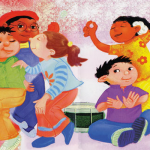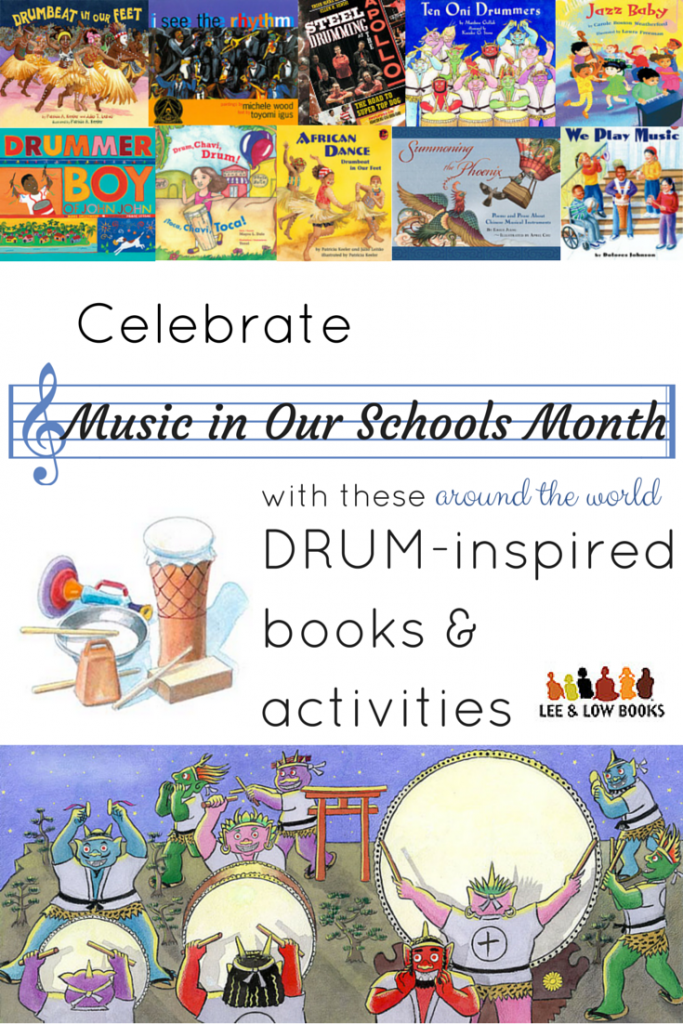March is Music in Our Schools Month. In support of music programs, music educators, and wiggling students trying to sneak a beat, we are celebrating (global) Music in Our Schools Month with DRUMS!
- Drum, Chavi, Drum!
- Drumbeat in Our Feet
- Drummer Boy of John John
- i see the rhythm
- Jazz Baby
- Steel Drumming at the Apollo: The Road to Super Top Dog
- Summoning the Phoenix: Poems and Prose About Chinese Musical Instruments
- Ten Oni Drummers
- We Play Music
Questions during reading:
- How can drums help people communicate? What can someone communicate through a drum?
- How do you think the musician(s) in this book wanted their music to make people feel?
- Is the drum a central part of this story or community? Why or why not? How would the story be different if another instrument were used, such as a guitar or flute?
- What words in the text describe how the drum sounds?
- Bring in other images of drums from around the world or compare two or more books featuring drums: What are the features of a drum? What do drums around the world have in common? How are drums unique from other instruments? What materials are best for making drums? What geometric shapes are best for making drums?
Activities:
- If you read more than one book featuring a drum: Post a world map and note which countries drums are found.
- Have students research the particular type of drum featured in the book. What materials are used for this type of drum? What characteristics does this type of drum have and what is special about the design? Is this drum used everyday/casually or for special holidays/significant times? What country or region does it originate? What genre of music is the drum used in today? Who are some famous drummers who use this kind of drum?
- Set up a listening station devoted to music including drums. Provide a range of musical genres. Leave covers available for students to explore. After students have an opportunity to listen to different kinds of music featuring or including drums, encourage students to share their reactions in writing. What images did the music bring to them as they listened with their eyes closed? What did they imagine as they heard the drums?
- Encourage students to make their own drum in class or at home. Students can make their own drums out of coffee cans, cylindrical oatmeal boxes, or plastic deli containers. Supply different materials (plastic wrap, paper, foil, etc.) for covering the opening so students can hear a variety of different sounding drums. Which ones make metallic sounds, loud sounds, soft sounds, sweet sounds, deep sounds? How can you make the sound change?
 For further reading on music and books:
For further reading on music and books:
Book and Activity Suggestions to Match Your Summer Adventure: Outdoor Summer Concerts
 Jill Eisenberg, our Senior Literacy Expert, began her career teaching English as a Foreign Language to second through sixth graders in Yilan, Taiwan as a Fulbright Fellow. She went on to become a literacy teacher for third grade in San Jose, CA as a Teach for America corps member. She is certified in Project Glad instruction to promote English language acquisition and academic achievement. In her column she offers teaching and literacy tips for educators.
Jill Eisenberg, our Senior Literacy Expert, began her career teaching English as a Foreign Language to second through sixth graders in Yilan, Taiwan as a Fulbright Fellow. She went on to become a literacy teacher for third grade in San Jose, CA as a Teach for America corps member. She is certified in Project Glad instruction to promote English language acquisition and academic achievement. In her column she offers teaching and literacy tips for educators.









